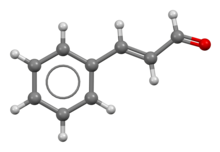
| |

| |

| |
| Names | |
|---|---|
| Preferred IUPAC name
(2E)-3-Phenylprop-2-enal | |
Other names
| |
| Identifiers | |
3D model (JSmol)
|
|
| 3DMet | |
| 1071571 | |
| ChEBI | |
| ChEMBL | |
| ChemSpider | |
| DrugBank | |
| ECHA InfoCard | 100.111.079 |
| EC Number |
|
| KEGG | |
PubChem CID
|
|
| RTECS number |
|
| UNII | |
CompTox Dashboard (EPA)
|
|
| |
| |
| Properties | |
| C9H8O | |
| Molar mass | 132.16 g/mol |
| Appearance | Yellow oil |
| Odor | Pungent, cinnamon-like |
| Density | 1.0497 g/mL |
| Melting point | −7.5 °C (18.5 °F; 265.6 K) |
| Boiling point | 248 °C (478 °F; 521 K) |
| Slightly soluble | |
| Solubility |
|
| −7.48×10−5 cm3/mol | |
Refractive index (nD)
|
1.6195 |
| Hazards | |
| GHS labelling: | |

| |
| Warning | |
| H315, H317, H319, H335 | |
| P261, P264, P271, P272, P280, P302+P352, P304+P340, P305+P351+P338, P312, P321, P332+P313, P333+P313, P337+P313, P362, P363, P403+P233, P405, P501 | |
| NFPA 704 (fire diamond) | |
| Flash point | 71 °C (160 °F; 344 K) |
| Lethal dose or concentration (LD, LC): | |
LD50 (median dose)
|
3400 mg/kg (rat, oral) |
| Related compounds | |
Related compounds
|
Cinnamic acid |
Except where otherwise noted, data are given for materials in their standard state (at 25 °C [77 °F], 100 kPa).
| |
Cinnamaldehyde is an organic compound with the formula or C₆H₅CH=CHCHO. Occurring naturally as predominantly the trans (E) isomer, it gives cinnamon its flavor and odor.[1] It is a phenylpropanoid that is naturally synthesized by the shikimate pathway.[2] This pale yellow, viscous liquid occurs in the bark of cinnamon trees and other species of the genus Cinnamomum. It is an essential oil. The bark of cinnamon tree contains high concentrations of cinnamaldehyde.[3]
- ^ "Cinnamon". Transport Information Service. Gesamtverband der Deutschen Versicherungswirtschaft e.V. Retrieved 2007-10-23.
- ^ Gutzeit, Herwig (2014). Plant Natural Products: Synthesis, Biological Functions and Practical Applications. Wiley. pp. 19–21. ISBN 978-3-527-33230-4.
- ^ PubChem. "Cinnamaldehyde". pubchem.ncbi.nlm.nih.gov. Retrieved 2019-10-18.

